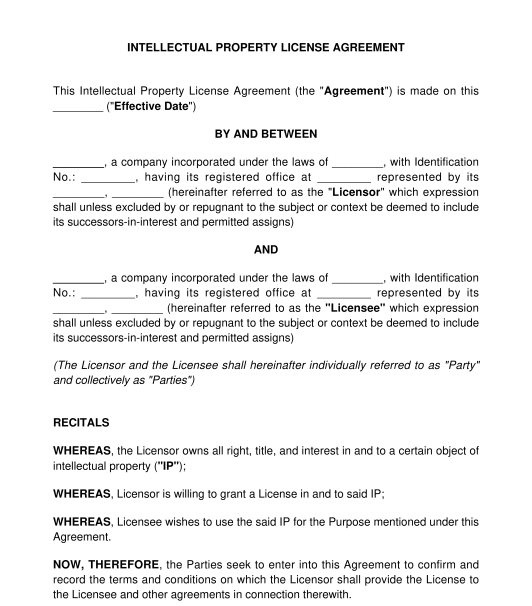 05-04-2025
05-04-2025

Answer a few questions and your document is created automatically.

Your document is ready! You will receive it in Word and PDF formats. You will be able to modify it.

 05-04-2025
05-04-2025
 Word and PDF
Word and PDF
 11 to 16 pages
11 to 16 pages



An Intellectual Property Licensing Agreement is a document under which the intellectual property ("IP") rights owner ("Licensor") authorizes another person to use such rights ("Licensee"), in exchange for a payment, known as a "Royalty". This Agreement can be used for any type of Intellectual Property License including patents, copyrights, trademarks, and designs.
Under the License Agreement, the ownership remains with the Licensor of IP rights while granting permission to the Licensee to utilize the IP in a particular manner for a limited period.
Under an Assignment Agreement, the Licensor gives away all the rights over the IP rights including ownership for consideration and will not be entitled to use such IP rights or receive regular Royalty payments on them. On the other side, under an Intellectual Property Licensing Agreement only usage rights are granted to the licensee while the licensor retains the ownership.
Yes, the Intellectual Property Licensing Agreement is mandatory as many of them are required to be registered to be a valid document. Moreover, having a written Intellectual Property Licensing Agreement will help in understanding the rights and obligations of each party and avoid potential disputes in the future.
A license is permission granted by the owner of the intellectual property (the Licensor) to another party (the Licensee) to use that intellectual property in a specific way. The Intellectual Property License Agreement clearly define what the Licensee is allowed to do with the IP including making copies, selling products based on IP, or modifying it for a specific use.
A Royalty is a payment made by the licensee to the licensor for the right to use the IP. It can be a percentage of revenue generated, a fixed fee or a combination of both.
Any person above the age of 18 years or registered entities who own the IP can enter into an Intellectual Property Licensing Agreement.
The duration can vary from a few months to several years. The parties considering the nature of the transaction and commercial viability the parties can decide the duration of an Intellectual Property Licensing Agreement.
The Intellectual Property Licensing Agreement will be legally binding when it has been printed on non-judicial stamp paper or e-stamp paper, and signed by each party. The value of the stamp paper would depend on the state in which it is executed. Each state in India has provisions in respect of the amount of stamp duty payable on such agreements. Information regarding the stamp duty payable can be found on the State government websites.
Each Party should sign and return a copy of the Intellectual Property Licensing Agreement. Where a company is a party to this agreement, it should ensure that the Intellectual Property Licensing Agreement is signed by an authorized signatory, which is usually a director as authorized by a board resolution of the company.
Each Party should keep a signed copy of the Intellectual Property Licensing Agreement. To do this, two different copies can be signed, or if only one copy is signed, it can be photocopied and then distributed between the parties.
Yes, depending on the nature of the IP, the registration is mandatory for an Intellectual Property Licensing Agreement to be valid. For example, patent and design assignments must be registered with the concerned controller or authority to be a valid agreement.
Registration of trademark Intellectual Property License Agreement is not mandatory under the law. However, registering it will create a public record and help in avoiding any future disputes.
The Intellectual Property Licensing Agreement must contain the following clauses:
Licensing of copyright: under the Copyright Act, 1957, the owner of the copyright can license the rights in copyright in writing. For granting licenses in respect of literary, dramatic, musical and artistic works in cinematography films and sound recordings can only be carried out through a registered copyright society.
Licensing of trademark: under the Trademarks Act, 1999, the licensing needs to be in writing. Only those license agreements registered with the Registrar will have protection under this Act.
Licensing of patents: under the Patents Act, 1970, the licensing agreement has to be in writing and registered with the Controller of Patents.
Licensing of design: under the Designs Act, 2000, the licensing agreement shall be writing and registered with the controller within 6 months from its execution.
A License Agreement is a contract and general principles of the Indian Contract Act, 1872 will be applicable.
You fill out a form. The document is created before your eyes as you respond to the questions.
At the end, you receive it in Word and PDF formats. You can modify it and reuse it.
Guides to help you
Intellectual Property License Agreement - Template
Country: India